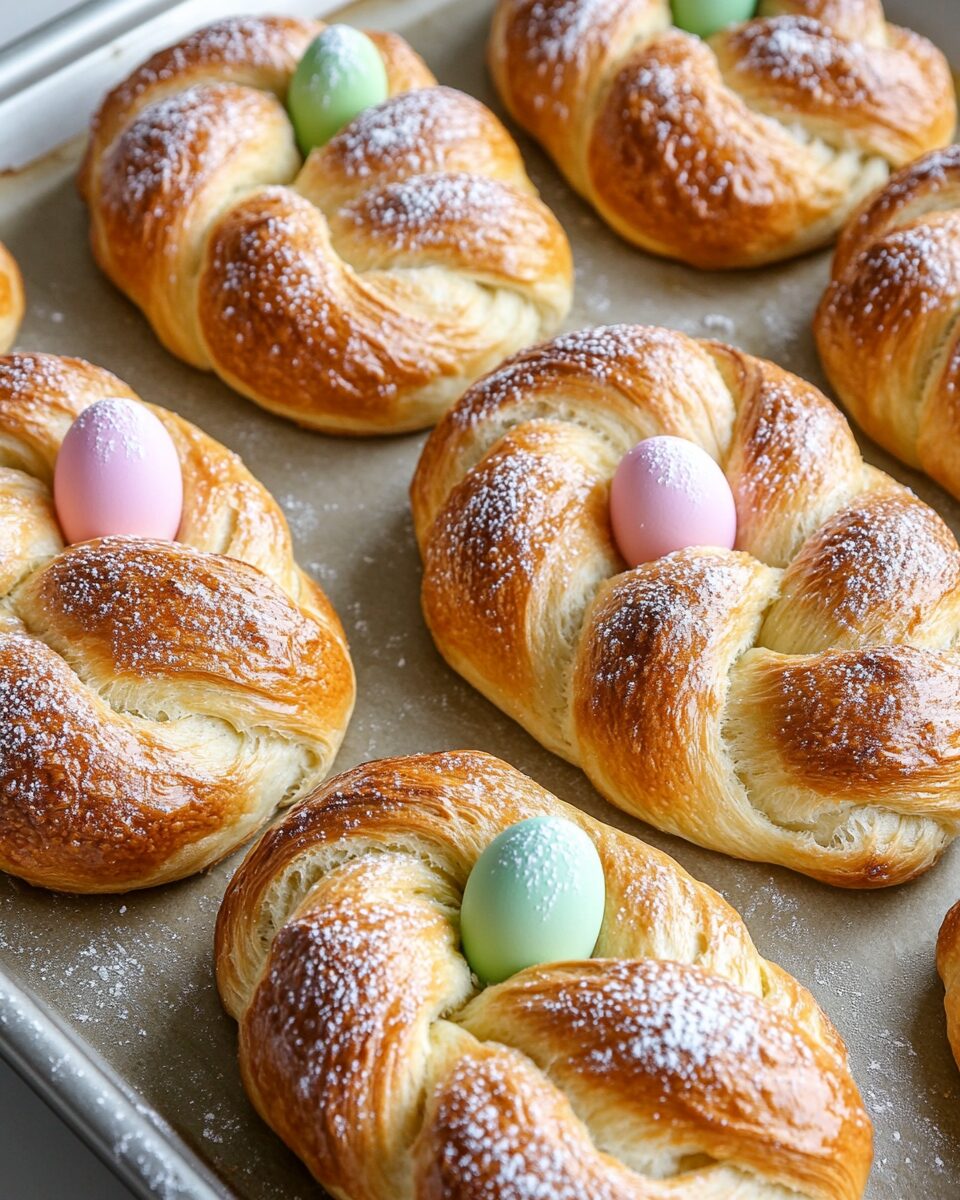Italian Easter Bread is a soft, sweet braided bread with a beautifully dyed Easter egg nestled in the middle. Traditionally made during Easter celebrations, this bread symbolizes renewal and the Christian belief in new life through Christ. The braid represents the Holy Trinity, while the eggs signify rebirth. This festive treat is perfect for Easter gatherings and makes a delightful centerpiece for your holiday table.
Full Recipe:
Ingredients
- 1 package (2 ¼ teaspoons) instant yeast
- 1 ¼ cups warm milk
- Pinch of salt
- ⅓ cup butter, at room temperature
- 2 eggs, lightly beaten
- ½ cup sugar
- 3 ½ to 4 ½ cups all-purpose flour
- 1 egg, beaten with 1 teaspoon of water (for egg wash)
- 6 dyed, uncooked Easter eggs (they will cook in the oven)
- Sprinkles for garnish
Directions
- Prepare the Dough: In a large mixing bowl, combine yeast, warm milk, salt, butter, eggs, and sugar. Add 2 cups of flour and mix until smooth. Gradually add the remaining flour until a dough forms.
- Knead the Dough: Knead the dough until smooth and elastic. If using a stand mixer, use the dough hook attachment. Add extra flour as needed to make the dough tacky but not sticky.
- First Rise: Transfer the dough to an oiled bowl, cover, and let it rise in a warm place for about 1 hour or until doubled in size.
- Shape the Bread: Punch down the dough and divide it into 12 equal pieces. Roll each piece into a 14-inch rope. Twist two ropes together to form a braid, then shape into a circular nest. Pinch the ends together and place on a lined baking sheet.
- Second Rise: Cover the braided nests with a towel and let them rise again for another hour.
- Prepare for Baking: Preheat the oven to 350°F (175°C). Brush the risen dough with the egg wash and sprinkle with colorful sprinkles.
- Add the Eggs: Gently place a dyed, uncooked Easter egg in the center of each nest, pressing down slightly.
- Bake: Bake in the preheated oven for 20-25 minutes or until golden brown. Remove from the oven and let cool on a wire rack before serving.
Nutrients (Per Serving)
- Calories: 289 kcal
- Carbohydrates: 23g
- Protein: 10g
- Fat: 18g
- Saturated Fat: 9g
- Cholesterol: 250mg
- Sodium: 196mg
- Potassium: 158mg
- Fiber: 1g
- Sugar: 20g
- Vitamin A: 714 IU
- Calcium: 93mg
- Iron: 1mg
This beautifully braided Italian Easter Bread is a sweet and festive addition to your Easter celebrations. Enjoy it fresh, with butter, or even as a decorative and meaningful table centerpiece!
The History and Origins of Italian Easter Bread
Italian Easter Bread, known as “Pane di Pasqua” in Italian, has roots dating back centuries. It is believed to have originated in Southern Italy, where many families still prepare it as part of their Easter celebrations. The tradition of baking sweet, enriched bread for religious holidays has been a long-standing custom in various cultures, with each region adding its own unique touch.
The recipe has evolved over generations, with different variations appearing across Italy and beyond. While some regions incorporate citrus zest and anise seeds for added flavor, others opt for simpler versions with a delicate sweetness. No matter the regional differences, the essence of the bread remains the same—a symbolic and flavorful way to commemorate Easter.
Symbolism of Italian Easter Bread
This bread is rich in symbolism, making it much more than a simple baked good. Each element of the bread carries a special meaning:
- The Braid: The three-stranded braid represents the Holy Trinity—God the Father, God the Son, and God the Holy Spirit. In some traditions, people use a two-strand braid to signify the bond of love and faith.
- The Eggs: The inclusion of dyed, uncooked eggs in the dough represents rebirth and renewal, mirroring the resurrection of Christ. The egg, an ancient symbol of new life, takes on additional spiritual significance during Easter.
- The Sweetness: The slight sweetness of the bread symbolizes the joy and celebration of the Easter season, marking the end of Lent and the beginning of a time of feasting and togetherness.
- The Sprinkles: The colorful sprinkles often used as garnish add to the festive and joyful nature of the bread, symbolizing the vibrant nature of life and the hope Easter brings.
How Italian Easter Bread is Enjoyed
Italian Easter Bread is enjoyed in various ways across different households. Traditionally, it is served on Easter Sunday, either as part of breakfast or alongside the main Easter meal. Some prefer to enjoy it with a spread of butter or jam, while others pair it with coffee or tea for a comforting treat.
This bread is also used as a centerpiece for Easter tables, with its bright colors and intricate braid making it a stunning decorative addition. Some families gift it to friends and loved ones as a gesture of goodwill and celebration.
Variations of Italian Easter Bread
While the classic version of Italian Easter Bread remains popular, several variations exist to cater to different tastes and preferences. Some of these include:
- Anise-Flavored Easter Bread: Anise seeds or anise extract are added to the dough for a distinct licorice-like aroma and taste.
- Citrus-Infused Easter Bread: Lemon or orange zest is incorporated for a fresh and zesty twist.
- Chocolate Chip Easter Bread: Small chocolate chips are mixed into the dough for a delightful sweetness.
- Savory Easter Bread: Some variations exist where the bread is made without sugar and instead features cheese and cured meats for a savory version.
- Gluten-Free Easter Bread: For those with dietary restrictions, a gluten-free alternative can be made using suitable flour substitutes while maintaining the traditional shape and symbolism.
Tips for Making the Perfect Italian Easter Bread
If you’re planning to make this bread for your Easter celebration, here are some helpful tips to ensure the best results:
- Use Fresh Yeast: Fresh, active yeast will help the bread rise properly and achieve a light, fluffy texture.
- Allow Enough Rising Time: Since this bread requires two rises, be patient and let the dough double in size before shaping and baking.
- Knead the Dough Well: Proper kneading develops gluten, giving the bread its soft and airy structure.
- Use Uncooked Eggs: The eggs will cook in the oven, ensuring they are safe to eat once the bread is baked.
- Experiment with Flavors: Feel free to personalize the recipe with spices, extracts, or fillings that match your preference.
- Store Properly: To keep the bread fresh, store it in an airtight container at room temperature for up to three days or refrigerate for longer shelf life.
Italian Easter Bread Around the World
While Italian Easter Bread is a distinct tradition, similar sweet and symbolic breads are found in other cultures:
- Greece: Tsoureki, a braided bread often flavored with mahlab and mastic, is a traditional Greek Easter bread that shares similarities with Pane di Pasqua.
- Spain and Portugal: “Rosca de Pascua” and “Folar de Páscoa” are variations of Easter bread with eggs and a sweet dough.
- Eastern Europe: Countries like Poland and Ukraine have their versions of Easter bread, such as Babka and Paska, which also incorporate eggs and braiding techniques.
These variations highlight the universal connection between bread and religious celebrations across different cultures.
Conclusion
Italian Easter Bread is more than just a delicious treat—it is a cherished tradition filled with symbolism, history, and cultural significance. Whether you are continuing a family custom or starting a new one, baking and sharing this bread during Easter is a meaningful way to celebrate the holiday. Its sweet, fluffy texture, combined with the vibrant colors of the dyed eggs, makes it a perfect addition to your Easter table. Enjoy it fresh, gift it to loved ones, or simply admire its beauty as part of your festivities. No matter how you choose to enjoy it, Italian Easter Bread remains a timeless symbol of joy, renewal, and faith.






